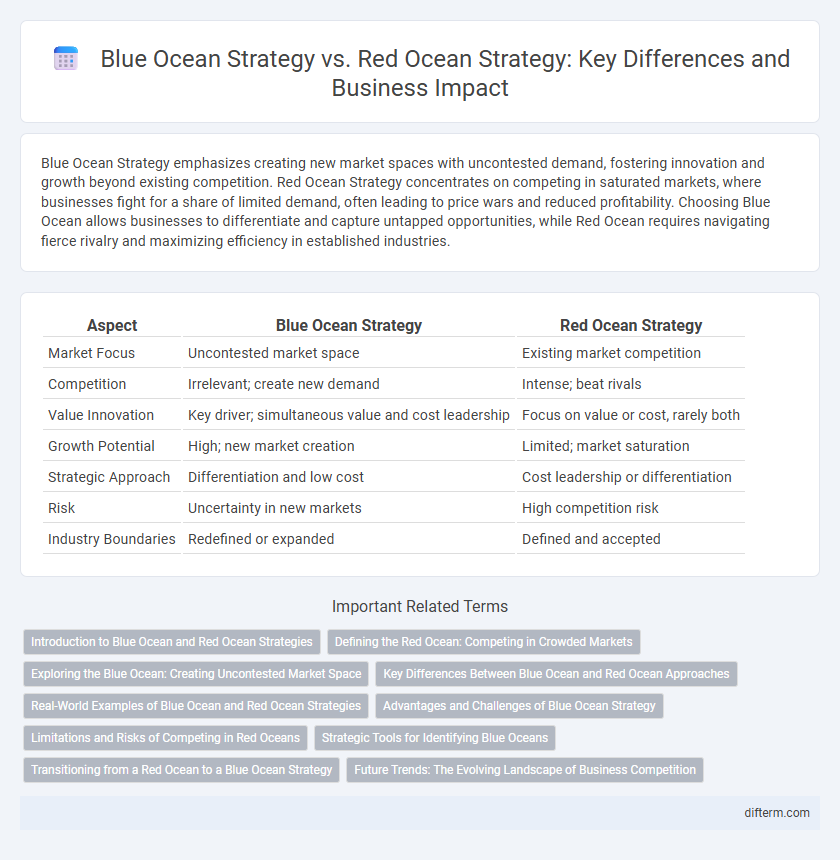Blue Ocean Strategy emphasizes creating new market spaces with uncontested demand, fostering innovation and growth beyond existing competition. Red Ocean Strategy concentrates on competing in saturated markets, where businesses fight for a share of limited demand, often leading to price wars and reduced profitability. Choosing Blue Ocean allows businesses to differentiate and capture untapped opportunities, while Red Ocean requires navigating fierce rivalry and maximizing efficiency in established industries.
Table of Comparison
| Aspect | Blue Ocean Strategy | Red Ocean Strategy |
|---|---|---|
| Market Focus | Uncontested market space | Existing market competition |
| Competition | Irrelevant; create new demand | Intense; beat rivals |
| Value Innovation | Key driver; simultaneous value and cost leadership | Focus on value or cost, rarely both |
| Growth Potential | High; new market creation | Limited; market saturation |
| Strategic Approach | Differentiation and low cost | Cost leadership or differentiation |
| Risk | Uncertainty in new markets | High competition risk |
| Industry Boundaries | Redefined or expanded | Defined and accepted |
Introduction to Blue Ocean and Red Ocean Strategies
Blue Ocean Strategy involves creating uncontested market spaces by innovating value propositions, thereby making competition irrelevant. Red Ocean Strategy focuses on competing within existing industries by outperforming rivals through cost leadership or differentiation. Companies adopting Blue Ocean seek to unlock new demand, while Red Ocean firms strive to capture share in saturated markets.
Defining the Red Ocean: Competing in Crowded Markets
Red Ocean Strategy involves competing in existing markets saturated with rivals, where businesses vie for limited demand by outperforming competitors. This approach often leads to intense rivalry, price wars, and reduced profit margins as companies strive to capture a share of established markets. The focus on incremental improvements and beating the competition characterizes the challenge of thriving in crowded, highly contested spaces.
Exploring the Blue Ocean: Creating Uncontested Market Space
Exploring the Blue Ocean Strategy involves creating uncontested market space by innovating value propositions that render competition irrelevant, unlike Red Ocean Strategy which focuses on competing within existing market boundaries. Businesses leveraging Blue Ocean identify unmet customer needs and tap into new demand, resulting in rapid growth and higher profitability. This strategic approach emphasizes differentiation and low cost simultaneously, breaking the traditional trade-off and transforming industry standards.
Key Differences Between Blue Ocean and Red Ocean Approaches
Blue Ocean Strategy focuses on creating uncontested market space by driving innovation and making competition irrelevant, while Red Ocean Strategy competes in existing markets with fixed demand, emphasizing outperforming rivals. Blue Ocean encourages value innovation and differentiation to unlock new consumer demand, contrasting with Red Ocean's cost-cutting and incremental improvements within saturated industries. Companies employing Blue Ocean aim for rapid growth with high profit margins, whereas Red Ocean organizations often face fierce price competition and shrinking profit potential.
Real-World Examples of Blue Ocean and Red Ocean Strategies
Blue Ocean Strategy emphasizes creating uncontested market space, as demonstrated by Cirque du Soleil, which redefined the circus industry by blending theater and acrobatics, avoiding direct competition. Red Ocean Strategy is exemplified by traditional airlines competing aggressively on price and routes, leading to saturated markets and reduced profitability. Companies adopting Blue Ocean strategies often achieve higher profit margins by generating new demand and making competition irrelevant, unlike Red Ocean competitors entrenched in fierce rivalry.
Advantages and Challenges of Blue Ocean Strategy
Blue Ocean Strategy offers businesses the advantage of creating uncontested market space, leading to rapid growth through innovation and differentiation, which minimizes direct competition found in Red Ocean markets. This approach allows companies to tap into new demand and achieve higher profit margins by focusing on value innovation rather than competing on existing market dimensions. However, challenges include the risk of market uncertainty, significant investment in research and development, and the difficulty of sustaining a unique strategic position as competitors may eventually imitate innovations.
Limitations and Risks of Competing in Red Oceans
Competing in red oceans presents significant limitations and risks, including intense rivalry that drives down profit margins and often leads to price wars. Strategies focused on outperforming competitors in existing markets frequently result in saturated industries with limited growth opportunities. Moreover, the emphasis on beating rivals can stifle innovation, causing businesses to struggle with differentiation and long-term sustainability.
Strategic Tools for Identifying Blue Oceans
Blue Ocean Strategy utilizes strategic tools such as the Strategy Canvas and the Four Actions Framework to identify untapped market spaces and create new demand. The Strategy Canvas visually maps current industry factors against competitors, highlighting opportunities for value innovation. The Four Actions Framework guides businesses to eliminate, reduce, raise, and create factors that differentiate their offerings, steering clear of saturated red oceans dominated by fierce competition.
Transitioning from a Red Ocean to a Blue Ocean Strategy
Transitioning from a Red Ocean to a Blue Ocean Strategy requires businesses to shift focus from fierce competition within existing market boundaries to creating new demand in uncontested market space. Companies must innovate value by simultaneously pursuing differentiation and low cost, breaking the value-cost trade-off commonly found in Red Oceans. This strategic move enables firms to unlock new growth opportunities and redefine market boundaries, leading to sustainable competitive advantage and increased profitability.
Future Trends: The Evolving Landscape of Business Competition
Blue Ocean Strategy emphasizes creating uncontested market space through innovation, steering away from saturated markets dominated by intense competition characteristic of Red Ocean Strategy. Future business trends indicate a shift towards value innovation, leveraging technology and sustainability to unlock new demand and growth opportunities beyond traditional boundaries. Companies adopting Blue Ocean principles position themselves to capitalize on emerging markets driven by digital transformation and changing consumer preferences, outpacing competitors fixated on incremental gains in crowded industries.
Blue Ocean Strategy vs Red Ocean Strategy Infographic

 difterm.com
difterm.com